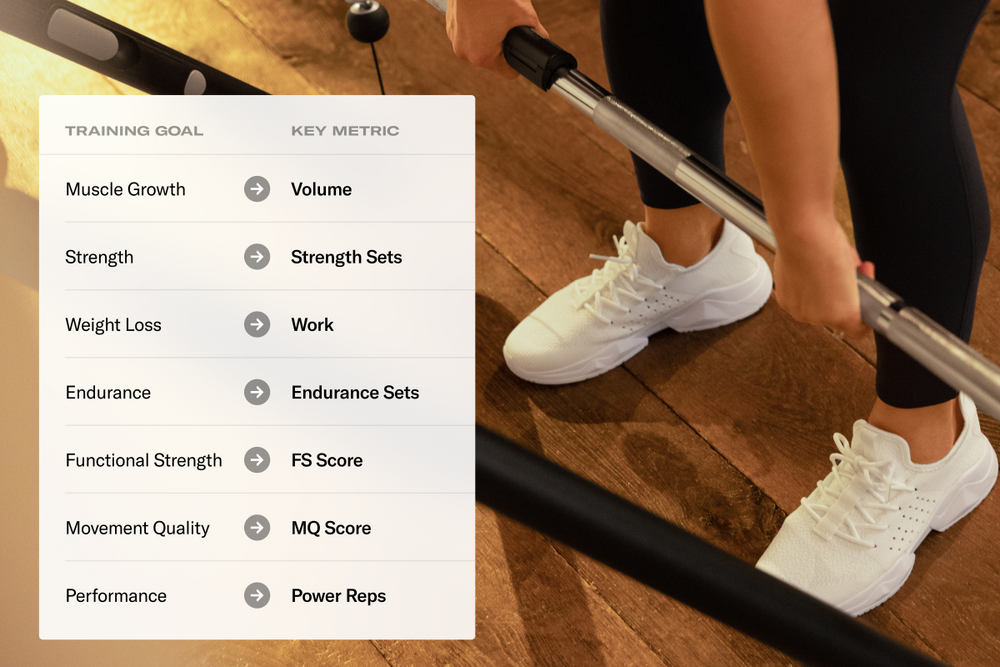Adaptive Weight Can Help You See Results and Reach Your Goals Faster

Here’s how this personalized approach to strength training can transform your workouts.
Before Tonal, building strength was limited to stacks of weights and rows of bulky machines in the gym or worse, sets of dumbbells cluttering up your home. Even then, you still had to figure out how much to lift for different exercises on your own, increase weights based on what was available on the rack, or wait around in the gym for machines to free up.
That’s why adaptive weight has revolutionized the game by offering a space-saving home solution that customizes the experience specifically to you. It takes all the guesswork out of strength training by determining your resistance for every exercise and increasing it in as little as one-pound increments as you grow stronger. Plus, it transforms the way you work out at home with dynamic weight modes that can challenge you with eccentric training or spot you when you’re struggling.
Adaptive weight breaks down numerous barriers so many of us face when it comes to strength training: It eliminates the intimidation factor, boosts your confidence, makes training more convenient and accessible in a package the size of a flat-screen television.
To help you understand how adaptive weight works, how it compares to traditional weights, and how you can leverage it to level up your training, here’s a breakdown of this ground-breaking technology.
What Is Adaptive Weight?
Tonal’s proprietary AI adaptive weight system uses electromagnetic technology to deliver 250 pounds of resistance on Tonal 2 and 200 pounds of resistance on Tonal 1 that intuitively adapts to you in real-time. That might sound futuristic, but electromagnetism is the principle that propels the motors in electric cars, rotates electric bikes, and levitates high-speed trains in Japan. Tonal’s adaptive weight leverages the same technology in a unique way.
Physically, the electromagnetic resistance engine within Tonal is a combination of computer chips, coils that generate an electromagnetic field controlled by those chips, and magnets that allow you to fight that field as you pull on a cable. It operates on some of the same physical principles as a traditional motor but with a far more advanced approach.
How Does Adaptive Weight Work?
The adaptive weight system performs thousands of calculations per second to emulate the physics of traditional weights. At the same time, it monitors your form to adjust the resistance and optimize every rep.
Since Tonal uses an electromagnetic motor instead of metal to create resistance, you can’t rely on momentum like you would with dumbbells and traditional weights to help you through each rep. And because it doesn’t rely on gravity, adaptive weight provides resistance to both the eccentric (when the muscle lengthens) and concentric (when the muscle contracts) phases of an exercise. That’s why it feels slightly heavier than traditional weights: You challenge your muscles with consistent resistance throughout the entire movement, and that type of overload results in improved strength.
Increasing the efficiency of your training is only one part of the package. Tonal can also add dynamic weight modes to your experience. Because it tracks speed, resistance, and form, it knows when you’re strongest—and when you’re struggling. This means it can add weight during each rep (Smart Flex) to build strength faster; reduce the weight to offer an assist when you’re tapped (Spotter mode); or step in to help you cross the finish line on fire (Burnout mode).
Plus, features like Drop Sets help you incorporate advanced muscle-building techniques into your training without needing a room full of equipment.
Dumbbells don’t stand a chance of accomplishing all that.
In addition to fine-tuning resistance, adaptive weight also enables detailed progress tracking with metrics like reps, sets, power, volume, range of motion, workout stats, and even offers feedback on your form. Armed with these insights, you can glean a thorough understanding of your training technique, while Tonal provides you with personalized weekly targets to make progress on your goals, hit new PRs, and keep building strength.
While this all sounds great, the results speak for themselves: Tonal’s member data shows that, on average, members increase their Strength Score, a comprehensive metric that measures total-body strength for more than 100 exercises, by 25 percent in the first 90 days.
How Are the Weight Recommendations Personalized?
At the start of your Tonal journey, you complete a strength assessment to calibrate the adaptive weight. During this assessment, Tonal measures your strength, speed, acceleration, force, power, and range of motion for a few basic exercises. From this, Tonal starts to learn your strength so it can adapt and fine-tune its personalized adaptive weight suggestions for over 200 on-Tonal exercises in the regularly-expanding library. The more you work out on Tonal, the better it gets to know you, and the more it can adjust to help you meet your goals.
Gym workouts, on the other hand, are a different story. You typically have to gauge how much to lift for different exercises yourself or jump weights based on what’s available on the rack, but adaptive weight adjusts in one-pound increments. Tonal recommends the ideal amount of resistance and increases it as you become stronger, so you feel challenged without being pushed past your limit too soon.
How Does Adaptive Weight Transform Each Workout?
Gone are the days when pushing your training to the next level required a gym commute, more equipment, a personal trainer, or an endless amount of self-motivation. Adaptive weight can help you level up by making it easier, safer, and more convenient than ever. Here’s how.
Increase time under tension with dynamic weight modes.
Enabled by adaptive weight, Tonal’s dynamic weight modes offer variable resistance training techniques, which otherwise need additional equipment or an extra set of hands, at the touch of a button. Tonal can add weight during each rep (Smart Flex) to build strength faster, reduce the weight to offer an assist when you’re tapped (Spotter mode), or help you cross the finish line on fire (Burnout mode).
Receive real-time feedback on your technique.
A study published in Medicine & Science in Sport & Exercise found that athletes developed greater maximal strength gains, more power output, and increased lean muscle mass from supervised heavy-resistance training compared with unsupervised work.
When you lift with adaptive weight, you can leverage Tonal’s artificial intelligence and motion sensor technology to receive detailed notes in real-time on your strength training technique. Form Feedback and Smart View give you specific and actionable cues for standing in the optimal position and using your full range of motion—just like having a personal trainer working out with you at home.
Train safer with resistance that turns on and off.
With Tonal’s Smart Handles and Smart Bar, you can turn adaptive weight on and off with the push of a button. This allows you to get into position safely and then click when you feel ready to lift and deload. No need to strain yourself or risk injury with awkward movements to set up your lift.
Use detailed progress tracking to crush your goals.
Tracking and measuring your progress is an essential part of any fitness journey. Yes, Tonal counts your reps and sets, but it also offers real-time data with in-depth workout summaries and insights on pacing, volume, and power along with key metrics and personalized weekly targets to help you measure your progress toward your goals.
Uncover strengths and weaknesses with Strength Score.
Tonal’s progress tracking goes far beyond run-of-the-mill numbers. Adaptive weight unlocks metrics that are exclusive to Tonal. With Strength Score, you can track your strength by muscle group and body region. By learning which muscle groups are stronger than others, you can map out fitness goals to build overall strength and balance for your entire body.
Related stories

- PRODUCT
- WORKOUTS
Tonal’s New Drop Sets Feature Helps You Build Muscle More Efficiently
Tonal now makes it easy to incorporate Drop Sets, an advanced lifting technique, allowing you to efficiently build muscle with no guesswork.
Read more
- PRODUCT
Introducing New Metrics For Your Training Goals
Tonal's nkey metrics and personalized targets help unlock better fitness outcomes. Here's what you need to know.
Read more
- EQUIPMENT
- PRODUCT
Experience the Future of Fitness with Tonal 2
Improve performance and build muscle faster with up to 250 pounds of adaptive weight, plus new features in an elevated design.
Read more- EQUIPMENT
- PRODUCT